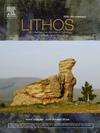Transitional chromitites within the Maqsad crust-mantle transition zone of the Semail ophiolite formed above the nascent forearc setting
IF 2.9
2区 地球科学
Q2 GEOCHEMISTRY & GEOPHYSICS
引用次数: 0
Abstract
The Semail ophiolite is a classic example of a well-preserved ophiolite, hosting over 450 documented podiform chromite deposits. This study investigates a transitional chromitite occurrence in the crust-mantle transition zone (CMTZ) of the Maqsad area within the Sumail massif of the Semail ophiolite. The chromitites, enveloped by dunites, exhibit massive and disseminated textures. Host harzburgites, representing upper mantle residues, underwent ∼20–35 % partial melting followed by metasomatism from subducting slab-derived melts/fluids. These peridotites show geochemical affinities with Izu-Bonin-Mariana (IBM) forearc peridotites, indicating a forearc tectonic setting. The Maqsad chromitites, with Cr# values of 54.3–66.2, are classified as transitional chromitites. Their geochemical features resemble chromites crystallized from mid-ocean ridge basalt (MORB) melts. Elevated oxygen fugacity (fO2) values compared to abyssal peridotites further support their formation in a supra-subduction zone (SSZ)environment. Based on the petrogeological and geochemical characteristics of the host rocks, we propose that the parental magma of the Maqsad transitional chromitites derived from a nascent forearc mantle above an SSZ setting, with MORB-like affinity.
Semail蛇绿岩Maqsad壳幔过渡带内的过渡性铬铁矿形成于弧前初生背景之上
Semail蛇绿岩是保存完好的蛇绿岩的典型例子,拥有450多个有记录的足状铬铁矿矿床。本文研究了塞梅尔蛇绿岩苏梅尔地块内马格萨德地区壳幔过渡带(CMTZ)的一种过渡性铬铁矿赋存。铬铁矿被灰岩包覆,呈块状浸染状。代表上地幔残留物的宿主哈尔茨堡土经历了~ 20 - 35%的部分熔融,然后是俯冲板块衍生的熔体/流体的交代作用。这些橄榄岩在地球化学上与伊豆-波宁-马里亚纳(IBM)弧前橄榄岩有亲缘关系,显示出弧前构造背景。Maqsad铬铁矿Cr#值为54.3 ~ 66.2,属于过渡性铬铁矿。地球化学特征类似洋中脊玄武岩(MORB)熔体结晶铬铁矿。与深海橄榄岩相比,高氧逸度(fO2)值进一步支持了它们在超俯冲带(SSZ)环境中的形成。根据寄主岩石的岩石地质和地球化学特征,我们认为马格萨德过渡型铬铁矿的母岩浆来自于SSZ背景之上的新生弧前地幔,具有类似morb的亲和作用。
本文章由计算机程序翻译,如有差异,请以英文原文为准。
求助全文
约1分钟内获得全文
求助全文
来源期刊

Lithos
地学-地球化学与地球物理
CiteScore
6.80
自引率
11.40%
发文量
286
审稿时长
3.5 months
期刊介绍:
Lithos publishes original research papers on the petrology, geochemistry and petrogenesis of igneous and metamorphic rocks. Papers on mineralogy/mineral physics related to petrology and petrogenetic problems are also welcomed.
 求助内容:
求助内容: 应助结果提醒方式:
应助结果提醒方式:


